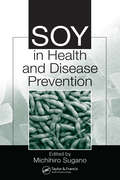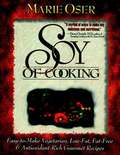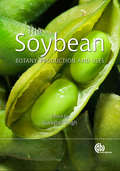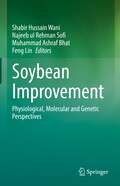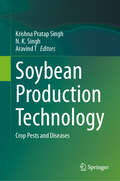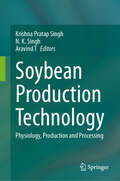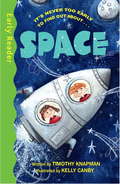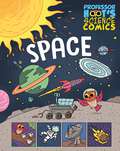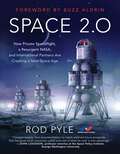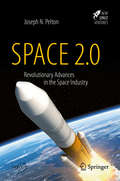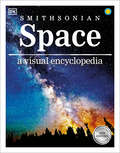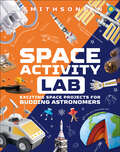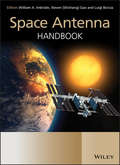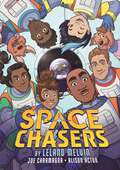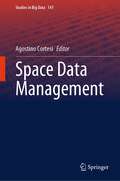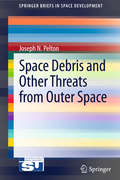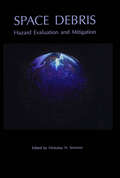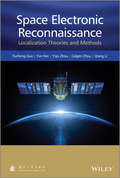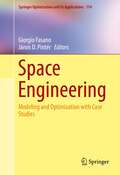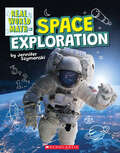- Table View
- List View
Soy in Health and Disease Prevention
by Michihiro SuganoWhile the western world has only recently become enamored with the soybean, East Asia has been consuming and enjoying the associated health benefits of this versatile proteinaceous legume for centuries. The Japanese in particular have devoted much energy to unraveling the mysteries and revealing the science of this oil-rich bean. The Fuji Foundatio
Soy of Cooking
by Marie Oserdelicious, nutritious, low-fat, fat-free vegetarian recipes, some using soy, some not
Soybean
by Guriqbal Singh David Mcneil Nawab Ali Dilip Panthee Rita Raghuvanshi Glen Hartman Prabal Ghosh Digvir Jayas Edward Oyekanmi G. Chauhan Saratha Kumudini Vineet Kumer Anita Rani A. Rao Matthew O'Neal Dennis Egli S. Shanmusgasundaram Lijuan Qiu J. Mishra Jonas ChianuThe soybean is a crop of global importance and is one of most frequently cultivated crops worldwide. It is rich in oil and protein, used for human and animal consumption as well as for industrial purposes. Soybean plants also play an important role in crop diversification and benefit the growth of other crops, adding nitrogen to the soil during crop rotation. With contributions from eminent researchers from around the world, The Soybean provides a concise coverage of all aspects of this important crop, including genetics and physiology, varietal improvement, production and protection technology, utilization and nutritional value.
Soybean Improvement: Physiological, Molecular and Genetic Perspectives
by Shabir Hussain Wani Feng Lin Najeeb ul Rehman Sofi Muhammad Ashraf BhatSoybean (Glycine max L. (Merr)) is one of the most important crops worldwide. Soybean seeds are vital for both protein meal and vegetable oil. Soybean was domesticated in China, and since last 4-5 decades it has become one of the most widely grown crops around the globe. The crop is grown on an anticipated 6% of the world’s arable land, and since the 1970s, the area in soybean production has the highest percentage increase compared to any other major crop. It is a major crop in the United States, Brazil, China and Argentina and important in many other countries. The cultivated soybean has one wild annual relative, G. soja, and 23 wild perennial relatives. Soybean has spread to many Asian countries two to three thousand years ago, but was not known in the West until the 18th century. Among the various constraints responsible for decrease in soybean yields are the biotic and abiotic stresses which have recently increased as a result of changing climatic scenarios at global level. A lot of work has been done for cultivar development and germplasm enhancement through conventional plant breeding. This has resulted in development of numerous high yielding and climate resilient soybean varieties. Despite of this development, plant breeding is long-term by nature, resource dependent and climate dependent. Due to the advancement in genomics and phenomics, significant insights have been gained in the identification of genes for yield improvement, tolerance to biotic and abiotic stress and increased quality parameters in soybean. Molecular breeding has become routine and with the advent of next generation sequencing technologies resulting in SNP based molecular markers, soybean improvement has taken a new dimension and resulted in mapping of genes for various traits that include disease resistance, insect resistance, high oil content and improved yield.This book includes chapters from renowned potential soybean scientists to discuss the latest updates on soybean molecular and genetic perspectives to elucidate the complex mechanisms to develop biotic and abiotic stress resilience in soybean. Recent studies on the improvement of oil quality and yield in soybean have also been incorporated.
Soybean Production Technology: Crop Pests and Diseases
by N. K. Singh Krishna Pratap Singh Aravind TThis book is dealing with the crop protection in soybean covering all the major insects’ pests, diseases and weeds infesting soybean. The main focus of the book is to provide a single point comprehensive reference on the pests and diseases in soybean covering all the latest advancements in the field. The book covers the taxonomic status, symptomatology, morphology, epidemiology and management of all the major pests and diseases in soybean. Special attention is given to different components of integrated pest management and the latest biotechnological interventions in the field. The pests and diseases are a major constraint in the soybean cultivation leading to significant yield losses. Meticulous understanding on these pests is critical for the accurate identification and adoption of the effective management strategies against them. This play a crucial role in enhancing the soybean production and thereby help in meeting the globally increasing demand for vegetable oil and protein. The book is of special interest to academicians, professionals and policy makers actively associated with the research on crop protection in soybean and a valuable source of reference to students, scientists, industrialists and farmers working on soybean.
Soybean Production Technology: Physiology, Production and Processing
by N. K. Singh Krishna Pratap Singh Aravind TThis contributed volume offers a comprehensive overview of the physiology, production, and processing of soybean, focusing on the latest advancements in soybean production technology. It covers recent innovations in the field, providing essential information on geographic distribution, uses, physiology, crop improvement, and processing of soybean. Soybean is a globally significant oilseed and legume crop, vital in meeting the rising global demand for vegetable oil and protein. Updated knowledge on key topics related to soybean production is crucial for adopting sustainable crop production strategies. This includes integrating indigenous knowledge with the latest cost-effective and efficient technological interventions. The book is of particular interest to academicians, professionals, and policymakers involved in soybean research and development. It also serves as a valuable reference for students, scientists, industrialists, and farmers working on various aspects of soybean.
Soziale Integration durch gemeinschaftliche Wohnkonzepte für die Silver Society: Kriterienkatalog für nutzerorientierte Immobilienentwicklung (Studien zum nachhaltigen Bauen und Wirtschaften)
by Yina ZhaoDiese Veröffenlichung untersucht Lösungansätzen für die Immobilienentwicklung zur Verbesserung der sozialen Integration und des persönlichen Wohlbefindens Älterer bei Gemeinschaftswohnformen.
Soziale Medien und die Streitkräfte
by Olivia Schneider Tibor Szvircsev Tresch Eva Moehlecke de BaseggioSoziale Medien haben die Kommunikation und Interaktion in der heutigen Gesellschaft grundlegend verändert. Sie werden nicht nur von Privatpersonen genutzt, sondern sind auch in Organisationen des öffentlichen Sektors wie den Streitkräften allgegenwärtig. Dieses Buch untersucht die Chancen und Risiken von Social Media im Kontext der Streitkräfte aus einer internationalen, sozialwissenschaftlichen Perspektive. Es erörtert die Auswirkungen sozialer Medien auf den Alltag von Militärangehörigen und analysiert, inwieweit soziale Medien deren Leistung beeinflussen, sei es als Ablenkung oder als Quelle wahrgenommener Wertschätzung. Sie beleuchtet insbesondere die Darstellung von Männlichkeit und Weiblichkeit in militärischen Social-Media-Kanälen, da die Art und Weise, wie das Geschlecht in den sozialen Medien dargestellt wird, Auswirkungen darauf hat, wie sich zukünftige Rekruten und - am anderen Ende des militärischen Karrierespektrums - Veteranen angesprochen fühlen. Das Buch befasst sich auch mit der neuen Form der Folgediskussion, die es den Streitkräften ermöglicht, mit der Bevölkerung zu interagieren. In den sozialen Medien werden die Streitkräfte öffentlich präsentiert, was die Meinung der Öffentlichkeit über sie prägt. Außerdem können die Streitkräfte die Debatten als Instrument zur Beobachtung der Einstellung der Gesellschaft zu ihnen oder zu Ereignissen, die sich auf die Gesellschaft auswirken, nutzen. Umgekehrt können die sozialen Medien den Militärangehörigen eine Stimme verleihen und ihnen ermöglichen, sich öffentlich Gehör zu verschaffen. Da Diskussionen in sozialen Medien nur begrenzt kontrollierbar sind, verändert der Kontext, in dem die Streitkräfte diskutiert werden, ihren Einflussbereich und führt möglicherweise zu einem Kontrollverlust. Ein extremes Beispiel hierfür ist die Nutzung sozialer Medien als Instrument zur strategischen Verbreitung von Fehlinformationen, um die öffentliche Meinung zu beeinflussen und die nationale Sicherheit zu gefährden. Darüber hinaus führt die Nutzung sozialer Medien zur Demoralisierung von Gegnern oder zur Beeinträchtigung ihrer Glaubwürdigkeit dazu, dass soziale Medien als Cyberwaffe betrachtet werden, die Politik und militärische Aktivitäten beeinflusst.
Soziale Netzwerke – Die Familie von heute: Recht und Politik der Regulierung
by Vanessa KirchSoziale Netzwerke haben eine Fülle von Problemen in Bezug auf die Privatsphäre und den Schutz personenbezogener Daten aufgeworfen. Die Nutzung sozialer Netzwerke ist zu einem zentralen Anliegen von Rechtswissenschaftlern, politischen Entscheidungsträgern und den Betreibern sowie den Nutzern dieser sozialen Netzwerke geworden. Dieses bahnbrechende Buch beleuchtet die Bedeutung des Datenschutzes im Zusammenhang mit den neuen elektronischen Kommunikationstechnologien von heute, da es widersprüchliche Ansprüche zum Schutz der nationalen und internationalen Sicherheit, der Freiheit des Internets und wirtschaftlicher Überlegungen aufzeigt. Auf der Grundlage des intellektuellen Rahmens der New Haven School of Jurisprudence stellt der Autor das geltende Recht zum Schutz der Privatsphäre und zu sozialen Medien in internationaler und vergleichender Perspektive dar und konzentriert sich dabei auf die Vereinigten Staaten, die Europäische Union und ihre Allgemeine Datenschutzverordnung von 2018 sowie auf Deutschland, das Vereinigte Königreich und Lateinamerika. Das Buch bewertet das geltende Recht, erörtert Alternativen und gibt Empfehlungen für eine öffentliche Ordnung der Menschenwürde. Übersetzt mit www.DeepL.com/Translator (kostenlose Version)
Space (Early Reader Non Fiction)
by Timothy KnapmanEarly Readers are stepping stones from picture books to reading books. A green Early Reader is a first factbook.Come and explore outer space. . .There are so many things to see - ride in a space ship to visit stars, galaxies and planets!Discover the Universe around you in this brand new non fiction Early Reader from Timothy Knapman, with full colour illustrations from Kelly Canby on every page.
Space (Professor Hoot's Science Comics #6)
by Minerva BlackEvery day brings a new adventure for Professor Hoot - and a new learning experience. Have you ever gazed at the night sky and wondered what else was out there among the stars? Professor Hoot hops aboard a rocket to find out all about space travel, the wonders of our solar system and takes a side trip to Mars to join the rovers in their exploration. Discover a great expanse of stars, satellites - and science. An entertaining comic strip approach to KS1 science topics, Professor Hoot's Science Comics are accessible and full of fun. Each book is an adventure and a chance for readers to learn something new, before testing their knowledge at the end of each book in Professor Hoot's quiz. Collect each adventure: Big Machines; Dangerous Animals; Dinosaurs; Robots and AI; Space; Volcanoes and Earthquakes.
Space 2.0: How Private Spaceflight, a Resurgent NASA, and International Partners are Creating a New Space Age
by Rod PyleWe're on the cusp of new era in the great adventure of space exploration. More than a half-century ago, humanity first hurled objects into space, and almost 50 years ago, astronauts first walked on the moon. Since then, we have explored Earth's orbit with shuttles, capsules, and space stations; sent robots to Mars, Venus, Mercury, Jupiter, Saturn, and Uranus; sampled a comet; sent telescopes into orbit; and charted most of our own planet. What does the future hold? In Space 2.0, space historian Rod Pyle, in collaboration with the National Space Society, will give you an inside look at the next few decades of spaceflight and long-term plans for exploration, utilization, and settlement. No longer the exclusive domain of government entities such as NASA and other national agencies, space exploration is rapidly becoming privatized, with entrepreneurial startups building huge rocket boosters, satellites, rocket engines, asteroid probes, prospecting craft, and even commercial lunar cargo landers to open this new frontier. Research into ever more sophisticated propulsion and life support systems will soon enable the journey to Mars and destinations deeper in our solar system. As these technologies continue to move forward, there are virtually no limits to human spaceflight and robotic exploration. While the world has waited since the Apollo lunar program for the next "giant leap," these critical innovations, most of which are within our grasp with today's technology, will change the way we live, both in space and on Earth. A new space age—and with it, a new age of peace and prosperity on Earth, and settlement beyond our planet—can be ours. Speaking with key leaders of the latest space programs and innovations, Pyle shares the excitement and promise of this new era of exploration and economic development. From NASA and the Russian space agency Roscosmos, to emerging leaders in the private sector such as SpaceX, Blue Origin, Moon Express, Virgin Galactic, and many others, Space 2.0 examines the new partnerships that are revolutionizing spaceflight and changing the way we reach for the stars.
Space 2.0: Revolutionary Advances in the Space Industry (Springer Praxis Books)
by Joseph N. PeltonA true revolution has rocked the space industry, as Silicon Valley and new startup companies around the world have shaken up the status quo. This has in turn triggered a hefty response among traditional aerospace companies, launching the sector into the new Space 2.0. This book explains how and why this remarkable change has happened, starting from the industry’s origins during the Space Age and working its way to the present day. No other industry in the world has experienced the dramatic shift in technology and services as rapidly as the field of satellite services and rocket launch systems has. This book analyzes the dynamic shift over the past decade in how satellites are designed, manufactured, launched, and operated. It also turns an eye to the future, discussing the amazing feats and potential issues we can expect from this shifting arena by 2030. With its beginner-friendly writing style and plethora of illustrations, this book serves as a perfect introductory text to students and professionals alike wishing to learn more about the key trends in the field of space applications and launch systems.
Space A Visual Encyclopedia (DK Children's Visual Encyclopedias)
by DKFrom the Moon, Sun, and planets of our Solar System to space exploration, black holes, and dark matter, this completely revised and updated children&’s encyclopedia covers all you need to know about the cosmos. The most up-to-date images from space agencies such as NASA and ESA combine with info panels, timelines, interviews, diagrams, and activities you can do at home to help you understand the majesty and wonder of space. Learn about the Space Race, the Apollo Moon Landings, the Voyager craft that first probed the outer planets, the Hubble telescope, and the International Space Station (ISS) – the state-of-the-art laboratory orbiting Earth. Find out about future missions, space tourism, and the latest discoveries in the furthest reaches of our galaxy. Discover how to find constellations and where to look for stars and planets, including Venus and Mars, in the night sky. Learn how galaxies such as our Milky Way were formed. Part of a series of best-selling encyclopedias for children, Space: A Children&’s Encyclopedia is a rocket ride from the beginning of time to the near future, and from planet Earth out to the furthest reaches of the Universe.
Space Activity Lab (DK Activity Lab)
by DKDiscover the wonders of our incredible Universe.This fun, fact-filled book is brimming with exciting outdoor experiments to help budding astronomers aged 9+ explore the secrets of space. Using household items, combine astronomy with art and craft by launching your own rocket, build a moon lander to learn how astronauts touch down safely on the moon&’s surface, and make a pinhole camera to observe a solar eclipse.Packed with photography, easy-to-follow instructions, and attention to detail, Space Activity Lab will make young astronomers excited from the get-go! Each of the super-fun make-and-do projects in this book comes with simple step-by-step photographs and instructions that will inspire children&’s imagination and reveal some of the secrets of space.This children&’s craft book on space offers: - 19 hands-on projects that appeals to kids aged 9+.- Materials easily found around the home with no specialist equipment needed.- Information boxes full of fascinating facts and panel stories that explain the science throughout the book.- A clear explanation how STEM is involved in creating the project or the results of the experiment.Perfect for kids who are interested in STEM, Space Activity Lab features projects that explore everything from the Solar System to meteorites and from the Milky Way to moon buggies. Design your own orrery to understand how planets orbit the Sun, create a cardboard model to explore the phases of the moon, and for when darkness falls, there&’s a starfinder section that shows you how to spot incredible constellations in the night sky, from The Plough to Orion.More in the seriesThe Activity Lab series inspires children to get hands-on with learning by creating exciting STEM projects in their favorite subject. If you liked Space Activity Lab, then why not try Dinosaur Activity Lab for budding palaeontologists, Cardboard Activity Lab for eco-friendly recycling fun, or Great STEM Projects experiments for all budding scientists?
Space Antenna Handbook
by Steven Shichang Gao William A. Imbriale Luigi BocciaThis book addresses a broad range of topics on antennas for space applications. First, it introduces the fundamental methodologies of space antenna design, modelling and analysis as well as the state-of-the-art and anticipated future technological developments. Each of the topics discussed are specialized and contextualized to the space sector. Furthermore, case studies are also provided to demonstrate the design and implementation of antennas in actual applications. Second, the authors present a detailed review of antenna designs for some popular applications such as satellite communications, space-borne synthetic aperture radar (SAR), Global Navigation Satellite Systems (GNSS) receivers, science instruments, radio astronomy, small satellites, and deep-space applications. Finally it presents the reader with a comprehensive path from space antenna development basics to specific individual applications. Key Features: Presents a detailed review of antenna designs for applications such as satellite communications, space-borne SAR, GNSS receivers, science instruments, small satellites, radio astronomy, deep-space applications Addresses the space antenna development from different angles, including electromagnetic, thermal and mechanical design strategies required for space qualification Includes numerous case studies to demonstrate how to design and implement antennas in practical scenarios Offers both an introduction for students in the field and an in-depth reference for antenna engineers who develop space antennas This book serves as an excellent reference for researchers, professionals and graduate students in the fields of antennas and propagation, electromagnetics, RF/microwave/millimetrewave systems, satellite communications, radars, satellite remote sensing, satellite navigation and spacecraft system engineering, It also aids engineers technical managers and professionals working on antenna and RF designs. Marketing and business people in satellites, wireless, and electronics area who want to acquire a basic understanding of the technology will also find this book of interest.
Space Capacity Building in the XXI Century (Studies in Space Policy #22)
by Stefano FerrettiThis book, edited by the European Space Policy Institute, is the first international publication, following UNISPACE+50, to analyze how space capacity building can empower the international community towards fully accessing all the economic and societal benefits that space assets and data can offer. New innovation models are increasingly spreading across various sectors and disciplines, including space, which is becoming an integral part of many societal activities (e.g. telecoms, weather, climate change and environmental monitoring, civil protection, infrastructures, transportation and navigation, healthcare and education). The book helps readers construct their own space capacity building roadmaps, which take into account key stakeholders and also new private actors, NGOs and civil society. Starting from a policy and strategy perspective, it addresses key aspects of capacity building, including innovation and exploration, global health, climate change and resilient societies. It outlines the available options and summarizes the ideal programmatic conditions for their successful implementation. Showcasing reflections from a range of senior space professionals around the world, with their unique perspectives and solutions, it provides a rich mosaic in which various cultural and policy approaches to space are translated into actionable programs and ideas so that space may truly benefit all of humankind.
Space Chasers by Leland Melvin (Space Chasers by Leland Melvin)
by Leland Melvin Joe CaramagnaWhen a team of brilliant kids-turned-astronauts find themselves in serious trouble in outer space, they must work together to get back home. This is the first book in an incredible middle-grade graphic novel series created by real life astronaut, Leland Melvin!Launch into action in T-Minus 3, 2, 1… When Tia Valor takes a test on a whim for an exclusive NASA program for middle schoolers, she never thought she’d pass. After all, she never really fit in at school. In fact, she’s been skipping school most days to work at her brother’s auto shop instead. But Leland Melvin, a famed astronaut, sees potential in Tia, and before she knows it, she’s part of a team of other talented kids training to launch to an advanced space station orbiting the earth. But the perils of space are unpredictable and Tia finds herself with only half her crew and no adults around to help. Now she must rely on her instincts and the quick thinking of her fellow kid astronauts to save the space station and their lives!Created by real-life astronaut Leland Melvin, Eisner-Award nominated comic creator Joe Caramagna, and brought to brilliant life by Alison Acton, SPACE CHASERS is a space adventure like no other.
Space Data Management (Studies in Big Data #141)
by Agostino CortesiThe book presents latest results pertaining to challenges faced by researchers in space data management. There are large number of highly important applications that currently rely upon data from satellites and space missions, ranging from weather prediction to monitoring of environmental pollution, climate change, marine traffic, agriculture, and urban planning, etc. The quality and quantity of space data poses new and specific challenges to the scientific community, covering the entire life cycle of space data management and with a need for an interdisciplinary approach. The chapters written by experts discusses impacts of these challenges, and report activities that can stimulate new research.
Space Debris and Other Threats from Outer Space
by Joseph N. PeltonThe mounting problem of space debris in low earth orbit and its threat to the operation of application satellites has been increasingly recognized as space activities increase. The efforts of the Inter Agency Space Debris Coordinating Committee (IADC) and UN COPUS have now led to international guidelines to mitigate the creation of new debris. This book discusses the technical studies being developed for active removal processes and otherwise mitigating problems of space debris, particularly in low earth orbit. This book also considers threats to space systems and the Earth that comes from natural causes such as asteroids, coronal mass ejections, and radiation. After more than half a century of space applications and explorations, the time has come to consider ways to provide sustainability for long-term space activities.
Space Debris: Hazard Evaluation and Debris
by Nickolay N. SmirnovWhen the first sputnik was launched and the space era began, few gave thought to the possible negative impact of putting satellites into orbit. In fact, man's space activity has led to the formation of a new media named "space debris," i.e. man-made objects and their fragments launched into space, currently inactive and no longer serving any useful
Space Electronic Reconnaissance
by Qiang Li Fucheng Guo Yun Fan Caigen Xhou Yiyu ZhouPresents the theories and applications of determining the position of an object in space through the use of satellitesAs the importance of space reconnaissance technology intensifies, more and more countries are investing money in building their own space reconnaissance satellites. Due to the secrecy and sensitivity of the operations, it is hard to find published papers and journals on the topic outside of military and governmental agencies. This book aims to fill the gap by presenting the various applications and basic principles of a very modern technology. The space electronic reconnaissance system in mono/multi-satellite platforms is a critical feature which can be used for detection, localization, tracking or identification of the various kinds of signal sources from radar, communication or navigation systems.Localization technology in space electronic reconnaissance uses single or multiple satellite receivers which receive signals from radar, communication and navigation emitters in the ground, ocean and space to specify the location of emitter. The methods, principles and technologies of different space electronic reconnaissance localization systems are introduced in this book, as are their performances, and the various methods are explained and analysed. Digital simulations illustrate the results.Presents the theories and applications of determining the position of an object in space through the use of satellitesIntroduces methods, principles and technologies of localization and tracking in the space electronic reconnaissance system, the localization algorithm and error in satellite system and near space platform system, and the tracking algorithm and error in single satellite-to-satellite tracking systemProvides the fundamentals, the mathematics, the limitations, the measurements, and systems, of localization with emphasis on defence industry applicationsHighly relevant for Engineers working in avionics, radar, communication, navigation and electronic warfare.Chapters include:- the introduction of space electronic reconnaissance localization technology, knowledge about the satellite orbit and basic terminology of passive localization, single satellite geolocation technology based on direction finding, three-satellite geolocation technology based on time difference of arrival (TDOA), two-satellite geolocation technology based on TDOA and frequency difference of arrival (FDOA), the single satellite localization technology based on kinematics theory, localization principles of near-space platform electronic reconnaissance systems, the orbit determination of single satellite-to-satellite tracking using bearings only(BO) information, the orbit determination of single satellite-to-satellite tracking using bearings and frequency information, the orbit determination of single satellite-to-satellite tracking using frequency only(FO) information. Each chapter ends with a problem and solution section, some using Matlab code.
Space Engineering
by Giorgio Fasano János D. PintérThis book presents a selection of advanced case studies that cover a substantial range of issues and real-world challenges and applications in space engineering. Vital mathematical modeling and numerical solution aspects of each application case study are presented in detail, with discussions of a range of advanced model development and solution techniques and tools. Space engineering challenges are discussed in the following contexts: *model space vehicle design *computation of optimal low thrust transfers *indirect optimization of spacecraft trajectories *resource-constrained scheduling, *packing problems in space *design of complex interplanetary trajectories *satellite constellation image acquisition *re-entry test vehicle configuration selection *collision risk assessment on perturbed orbits *optimal robust design of hybrid rocket engines *nonlinear regression analysis in space engineering *regression-based sensitivity analysis and robust design *low-thrust multi-revolution orbit transfers *modeling and optimization of balance layout problems *pilot-induced oscillations alleviation *modeling and optimization of hybrid transfers to near-Earth objects *probabilistic safety analysis of the collision between space debris and satellite *flatness-based low-thrust trajectory optimization for spacecraft proximity operations The contributing authors are expert researchers and practitioners in either the space engineering and/or in the applied optimization fields. Researchers and practitioners working in various applied aspects of space engineering will find this book practical and informative. Academics, graduate and post-graduate students in aerospace engineering, applied mathematics, operations research, optimization, and optimal control, will find this book useful.
Space Exploration (Real World Math)
by Jennifer SzymanskiGrab your space suit and get ready to use math to explore space!3 … 2 … 1 … blast off! Space scientists use math every day to explore our universe. Join a real astronomer on an amazing adventure to COUNT the planets, MEASURE the stars, ADD on the space station, and more. Then test your math skills with special You Can Do It challenges.This brand-new series demonstrates how math skills can be applied to high-interest topics and careers in Coding, Building, Tracking Animals, and Space Exploration. The K-2 math concepts include counting 1-100 with basic addition and subtraction, using the power of 10, measuring, and simple geometry. Real world scientists, architects, programmers, and mathematicians model hands-on, from-the-field experiences in a way that will make children excited to use and expand their math skills!
Space Exploration (The Space Traveller's Guide)
by Giles SparrowTop tips for space travellers! Learn how to explore your solar system in this up-close, expert guide.The Space Traveller's Guide: Space Exploration is your personal tour of what we've done and where we're headed as humans explore our Universe. Learn about the epic technology and courageous trailblazers that have touched the cosmos, from satellites to moon walks, rockets to robots on Mars. Includes 'Traveller's Tips' for surviving the extreme conditions in space, and don't miss the real-life tour photos at the back!The Space Traveller's Guide series is the perfect one-stop-shop for space lovers, brought to you by expert astronomy and physics author Giles Sparrow. It includes astounding facts to inspire young space-travel hopefuls, plus humorous cartoons to draw them through the pages, and presents key science learning in an accessible format for readers aged 9 and up.Contents list, Space Exploration: Out of this world / Rockets into space / Amazing satellites / Spaceships for humans / Space stations / Living and working in space / Missions to the Moon / Exploring the Moon / Probes to the planets / Robot explorers / Into the future / Beyond the solar system / Tour snapshots / Glossary / Resources / IndexThe series includes: Earth and the Inner Planets, The Outer Planets, The Sun and Stars and Space Exploration
